
In the early seventies the copies made at the Fuji-Gen factory were so good, the big American manufacturers talked to their lawyers. As far as I know there were no court cases, but the term «lawsuit guitars» has stuck ever since. Gibson patented their open-book headstocks, making the distributors order new shapes from their Fuji-Gen or Matsumoku factories around 1975. «Ibanez» is not a factory, it is a brand and a logo put on the headstocks at the request of one of the distributors.
This means my Arbiter or Kimbara could well be made by the same people who put together my 2351, and the recent red CSL «330» will bear the fingerprints of the workers who were told to drop the logo on my unbranded dark cherry one.
In any case, these are extremely well made instruments, and along with the connection to my younger self and my rock’n’roll dreams, these show incredible value for money even though prices on eBay have risen.
To prove this point: Fender chose Fuji-Gen Gakki to produce their first Japanese editions. Ibanez moved on to establish their own versatile collection leaning towards the metal/superstrat market, and the current Artcore models show the Gibson influence still present.
I went into a period of «old is good» after the «one of each» phase. The Tulip pair, the nameless sixties thin plank lent to a friend and not returned, the early Ibanez Strat-inspired 2020 were eventually deemed to be outside the concept of this collection. Even the Custom Agent and the possible Hondo were sold as they did not meet my guideline of having an open-book headstock to qualify as a lawsuit period guitar. Doesn’t mean I won’t compromise, though – see the Goldtop below.
I like the idea of having both the original and the copy. Sunbursts, Recordings, semi-solids, and even the faithful Strat replica. I would very much like an Ibanez «Tele» which was one of the often fingered at Imerslund. When I get rich, I’ll buy an LP Professional to match the copy. But then again, I recently got a copy of a Les Paul Junior and immediately sold the original.
Ibanez 2351M
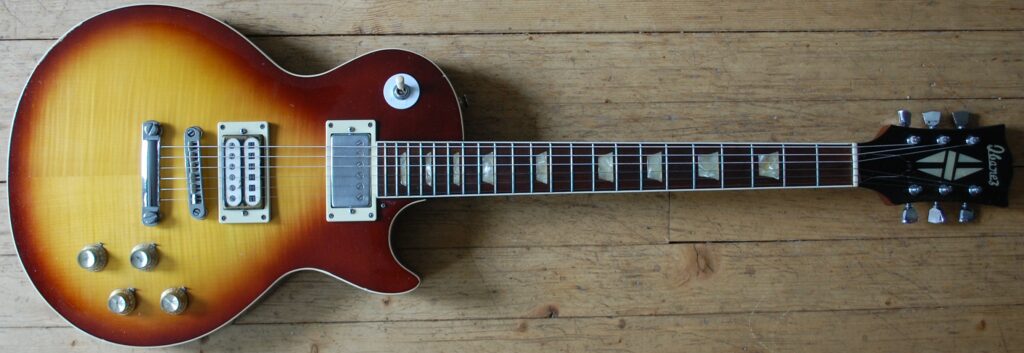
Ibanez 2351M 1973 (1973-1978, 2001)
Pre serial number
Two humbuckers (one semi-covered zebra), standard 2 volume, 2 tone. Pancake body with flamed maple veneer, singlecut, bolt-on bound neck. Custom-inspired headstock inlay.
Ibanez is one of the early Japanese guitar makers, in spite of the Iberian sounding name. I recommend delving into the story by way of several dedicated books.
At first put to use jamming with my tutor Odd Arne, later used in Namsos Ten-Sing both in religious and secular settings. During my CD release party I performed Warmer Welcome on the five available strings, as the repairing was scheduled for later.
Odd Arne Jacobsen from Tromsø was my tutor for about a year. His contribution til my understanding of music and the guitar simply cannot be overrated. He actually taught me 144 chords in about fifteen minutes, and just as importantly, he taught me the art of listening and communicating. Standard procedure was him calling out the chords as we played, keeping both my mind and my fingers on edge.
He had a Gibson Les Paul Gold Top Deluxe (the one with the mini ‘buckers), the sound of which made me reconsider getting a Strat to copy Jimi. Ever since, the sound of a neck humbucker with a bridge rolled in is The Sound of an electric guitar. Later I’ve been thinking: One of the first grown-up songs I really liked was Tennessee Ernie Ford’s version of Sixteen Tons. Could it be it’s the sound of the clarinet I am trying to achieve by way of a Gibson neck humbucker?
I could not afford a Gibson, they were £450 in those days. He recommended the Hagström Swede as used by Larry Coryell, a favourite of ours. The third choice was Ibanez, and after my Confirmation ceremony in Oslo’s City Hall I brought my gift money and my savings, a total of £140, to Imerslund, who seemed to never tire of a kid who wanted to try out guitars. I got a Dynacord amp and a Colorsound wah-fuzz as well; I could make a noise, but the pedal got left behind in Ten-Sing’s practice studio. The loss was dampened by the thought of national heroes Prudence using the same place. Maybe Åge has it? I remember sneaking in to test his keyboard player’s Solina String Ensemble when they had a break from rehearsing his first solo album. I found the same model on eBay in 2019, so now it’s sort of back, even though it will never replace the Weeping Demon on the board.
A few years later my interest waned, and I sold it to my good friend Stein Roger. When he got wind of my CD project he wondered if I would like to buy it back. Of course! He needed to think twice; though, as it had been both his and his son’s first serious guitar. I gave him an offer he didn’t want to refuse, and picked it up in Levanger on my way from Northern Norway in the summer of 2001. It was the prodigal son coming home, missing one tuner, one strap button, and one control knob. Gitardoktor’n (English readers figure this out) Knut Myhrvold provided spares and TLC, and it will never stray from my side again.
The sound is uncannily close to original Gibsons, but of course putting the original next to it will show and sound the difference. Lighter, veneer is not solid maple, bolt-on feels different than set-neck, but it sings. And holds the memories.
This is the story as presented in Guitar and Bass in May 2006.



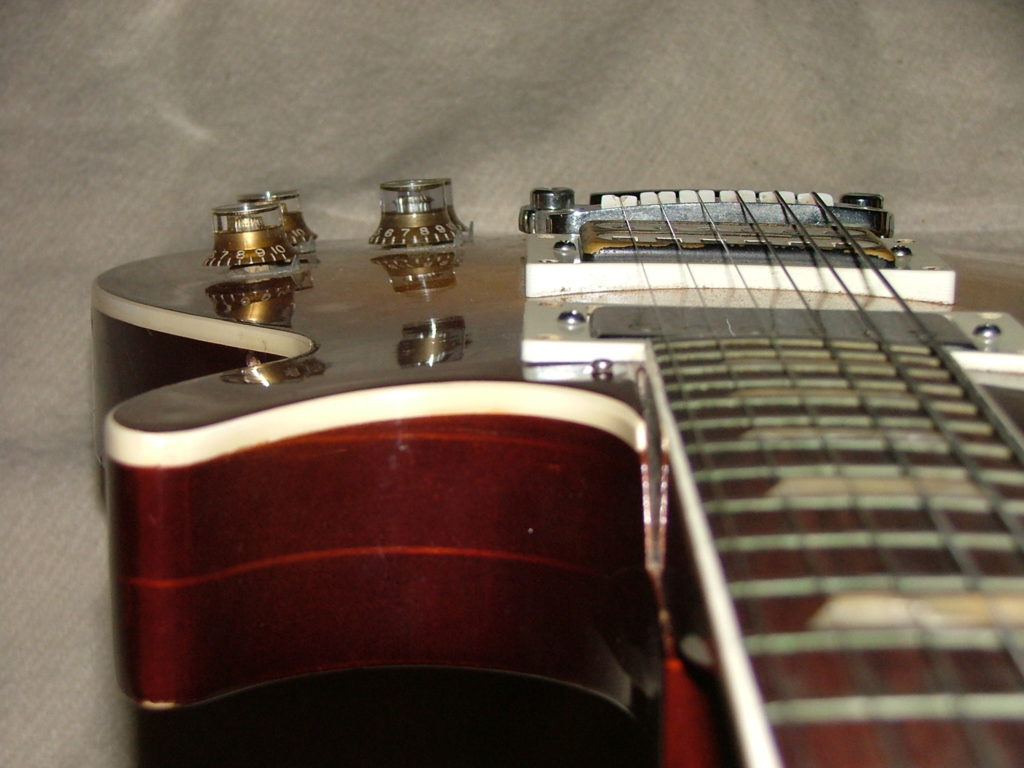

Ibanez 2388 B/DX

Ibanez 2388 B/DX 70s (2008)
Two pickups with three-way switch, two volume, two tone, three-piece through-neck construction with bound body wings.
“Ric********* 4003” copy, first published on eBay with the R word written in full. Soon retracted, but showed its wavy head again a little later without compromising references. R**********r is reputedly the strictest in the business, going down hard on copies and unauthorised namedropping. I believe they are the only company never to have anything produced outside the US.
Given the prices on the original ******backers, an amateur collector with a penchant for Ibanez lawsuit models is drawn to the copies.
«The late» Chris Squire is of course the main reason why I put in a bid for this. Putting «the late» in brackets is not disrespectful to a dead bass icon, it even says so on an official commemorative placque; it refers to his well-known tendency to appear late for everything including concerts.
He could also appear to be rather brusque, at least on a cold november night underneath Oslo Concert House. I don’t know if he listened to the copy of (42) I gave him? I hope so. I have bought CDs from him, and he was generous with signatures and greetings. He is missed greatly in the world of prog.
Back to the instrument, It appeared the join between through-neck and body wings was starting to crack. The neck was bending upwards from the string pull, making it impossible to play. The cracks were visible in the photos, so I probably wouldn’t be able to ask for a refund. Oh well, it could go on the wall. Art is known to cost more than this.
Then again, I can be relentless at times. I disassembled it into small pieces and tried some bending and stretching. What could keep the neck straight? Or straighter – there was an extreme backwards arching, but no twisting, fortunately.
I breathed deeply and screwed in two neck plates, each bridging the cracks below the neck heel. It worked. Stringing up brought the neck bend back close to normal, and a few twists of the truss rod fixed correct and playable string height along the whole fretboard. Instant Chris on a budget, bass solos were never easier.












Kay Effector

Kay (or Univox) Effector 70s (2011)
Bolt-on, two humbuckers; built-in effects: Phase in/out, echo, tremolo, wah, whirlwind, fuzz. Volume and tone, plus speed control. Output to amp and headphones.
The unorthodox has always appealed to me. I saw Steve Hackett on his first solo concert promoting Please Don’t Touch in Oslo in 1978 (“This the first gig this band has ever done”, he proudly proclaimed). He opened his show playing a Roland synth guitar, a Les Paul-shaped dashboard-featuring instrument able to make strange sounds. I wanted one.
A year later Steve Howes second solo effort was on the turntable, and inside the gatefold cover was the Les Paul Recording. Controls in abundance. I wanted one.
Sometime in the mid-eighties the Steves Howe and Hackett joined forces to record the GTR album. I wanted it; that I could afford.
As I delved into eBay twenty-five years later I found this. Not sure if I would ever be able to afford a proper Recording (and Roland GS-500 was both expensive and scarce) I decided to check out the Kay. Checking out, to a collector, means buying. Both weird and workable, the fuzz is probably the most convincing, and the autowah works fine. My pedal board does these things better, but I like the idea of having everything on hand. Literally. These Japanese ventures happen to be solid and playable, so this is a keeper along with the Recording and its recently acquired apprentices. I’ll bear with the headstock not having a proper open book shape.







Burny Super Grade Sustainer

Burny Super Grade Sustainer (2016)
Produced 2004-2007
A LP by any other name; at least as the S in Super Grade looks uncannily like a L and the G resembles a P. As Steve Hackett plays Burnys, I believe we’re good on this one. One volume one tone, and one pickup is a Fernandes Sustainer, which means you can play a note and go out for tea, and it will still be sounding when you come back.
And now is the time for a Steve Hackett story: He played his acoustic tour in Tromsø in the late noughties. I have a thing about going backstage to say hi and get autographs, so I hopefully knocked on the door marked «Backstage», half expecting a grumpy tour manager or an eager local security guard. But who opens the door but Mr. Hackett himself, tea cup in hand. We got to chat about his first ever solo concert in Oslo in 1978, and the second Oslo show in the spring of 1979, when a fan gave him a single rose as the band left the stage. He remembered. The fan, of course, was me. Awfully nice chap, Steve Hackett.
The Burny mentioned at the start of this ranting has not been played a lot, but there is a feeling of solid quality in build and sound. I would wish for a stadium, or maybe the O2 or Madison Square Garden to test this one with sustainer switched on. At the time of writing the limit of attendees is 20, so maybe it would feel a bit empty anyway.
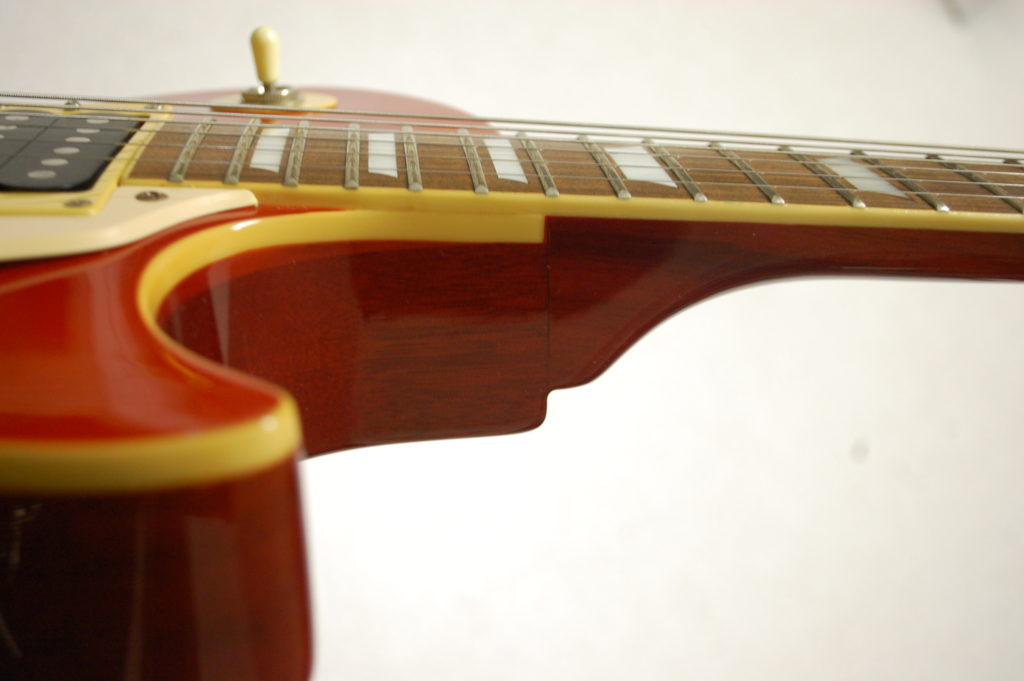


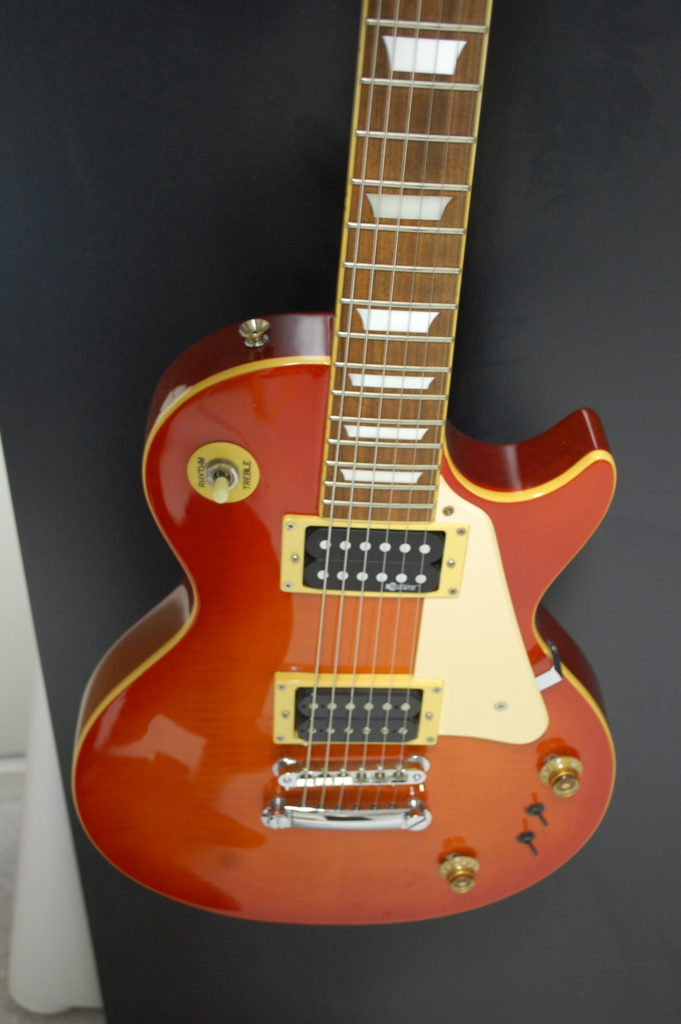
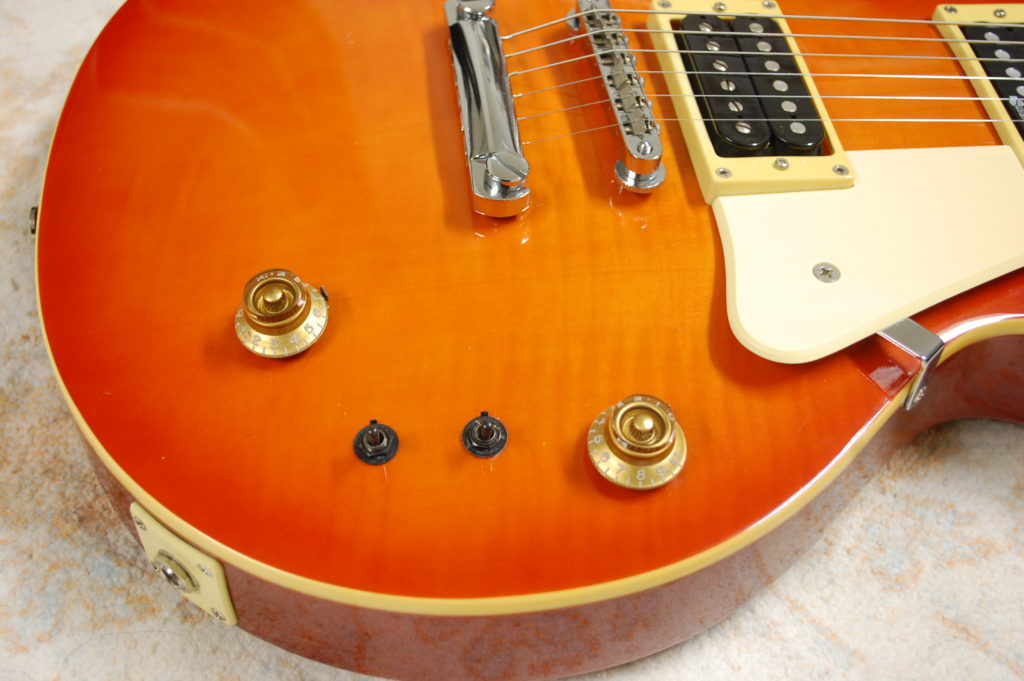
The Sunbursts


Given my history as an Ibanez owner from as early as 1973, I love to explore the so-called lawsuit era guitars, that is, well-made Japanese copies of (mainly) Gibson’s classic model. Still, after nearly fifty years, they work and sound extremely well, and all my lawsuit models are straight-necked and buzz-free. Elsewhere you will find copies of Les Paul low impedance models, 330s, and two «Strats» and one «Rick». Right here are three Sunbursts that along with my 2351 make up a quartet of Japan’s finest from the seventies. Personal opinion, of course.
One aspect of collecting things is having a number of items with common characteristics and some small differences that only a fellow collector will be able to discern. So welcome to these three. One is certain to be from Matsumoku, who along with Moridaira and Fuji-Gen were leading manufacturers for export. However, the world of manufacturers, distributors and dealers in the seventies is quite hard to navigate. I repeat, Ibanez is not a factory, just like Arbiter, CSL, Antoria and other brands may have had their logos put on by the very same people.
Around 2011 the lawsuit sunbursts were about £250 on eBay, which is why a number of Japanese seventies models happened upon my doorstep. I have since sold some of them as they did not conform to my later rule of an open-book headstock being obligatory. But here are three keepers.
Kimbara «Les Paul» 70’s (2011)
1044072
Made at the Matsumoku factory, easily identifiable by the words ‘Steel Reinforced Neck’ stamped on the neck plate, also as they were known to fit three pickup mounting screws to allow even more exact alignment against the strings. It has been refinished at the back (lacquer still slightly sticky on reception), and the machine heads may be the third set, and jack socket and strap button has been replaced. But the electronics are originial, according to the previous owner. The front is still beautiful, and the fretboard invites to fast and flowing playing.
Arbiter «Les Paul» (2011)
1054626
Probably Matsumoku, could be Kawai Teisco according to sources on the Internet.
Anyway, Arbiter is a British distributor’s brand, and this one has been played quite a lot since acquisition as I have kept it close at hand for spontaneous playing. Works perfectly with the Blackface monster stack (see photo).
Maya «Les Paul» 70s (2013)
The Maya was £150 only, and there were some issues. But at that price I am not complaining. A sunburst Les Paul copy is beautiful anyway, and at the time of writing she is in the able hands of my friend Stewart who is commissioned to put in new pickups.



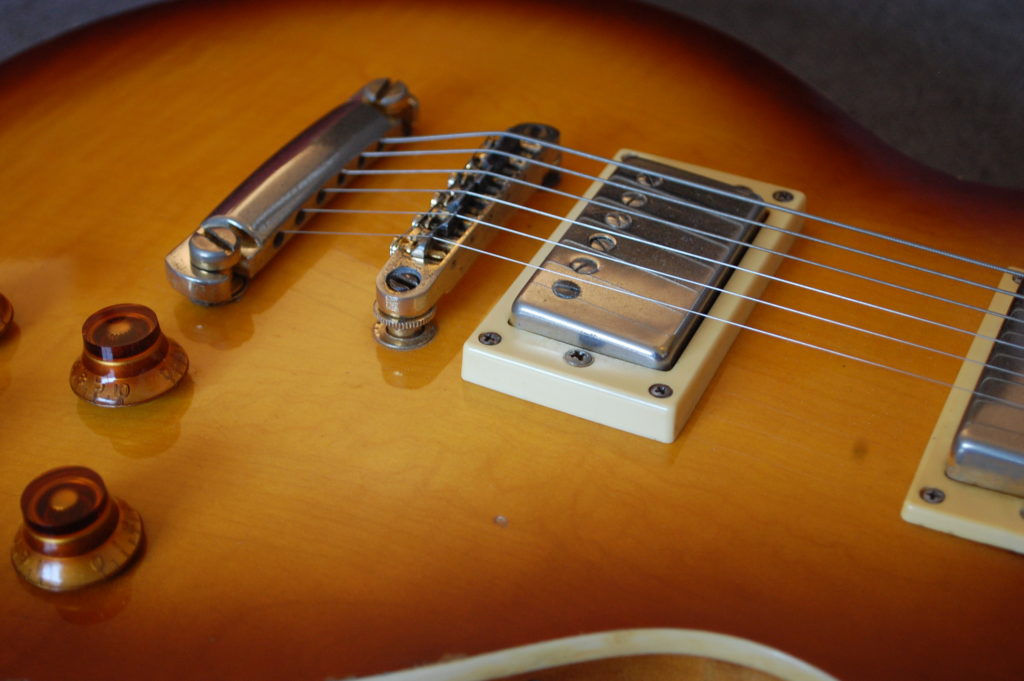
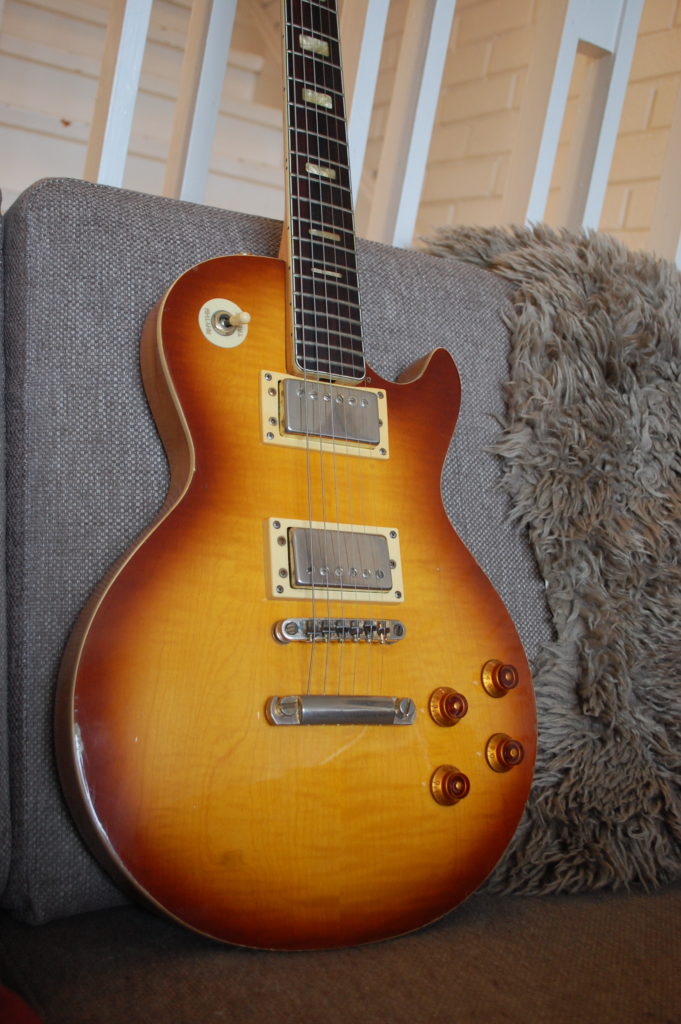


Kimbara gallery


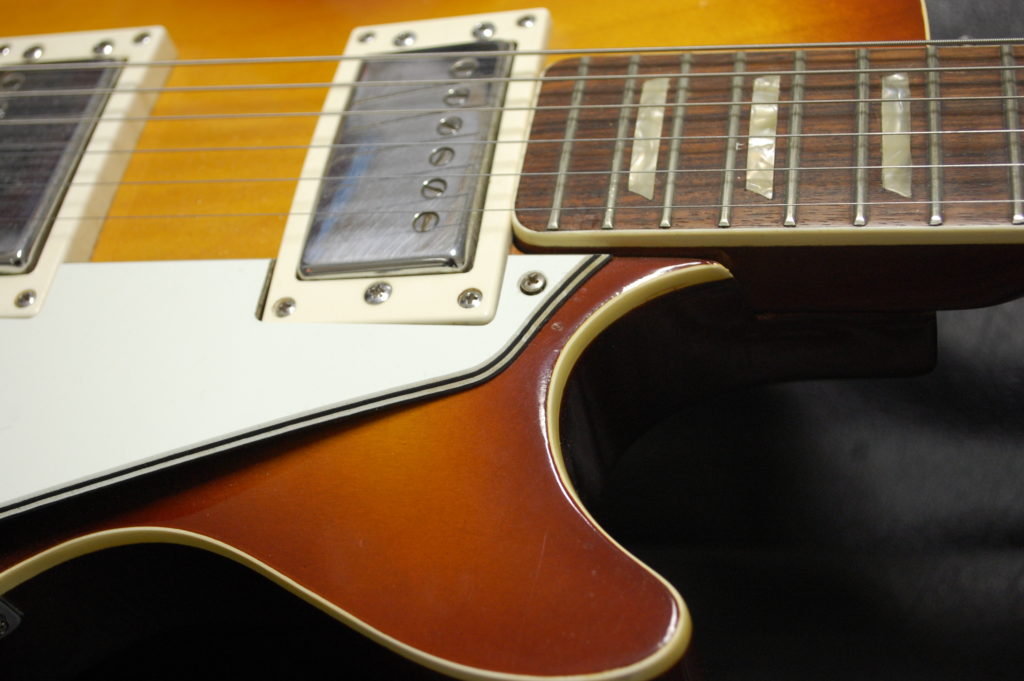


Arbiter gallery
Ibanez 2372
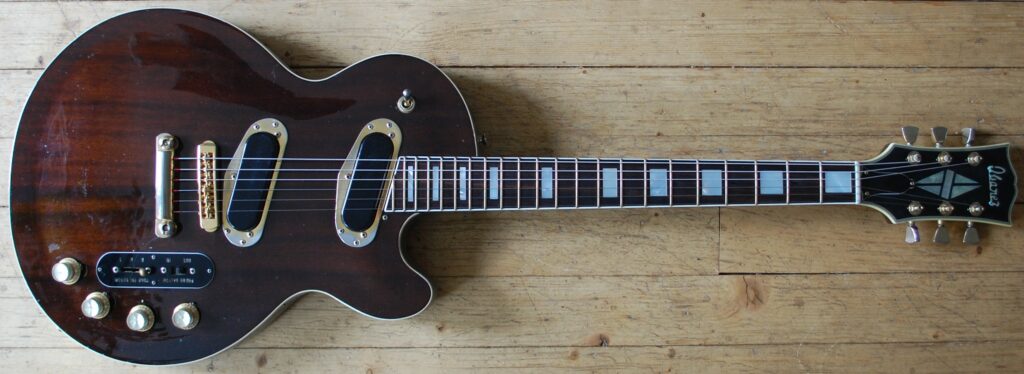
Ibanez 2372 «Professional» (2017)
The middle sibling in Lester’s personal family was the Gibson Les Paul Professional, with a slightly wider body than the Standard. It was preceded by the Personal, and the youngest and most popular was named the Recording which had retained the Standard shape. Low-impedance pickups and a number of knobs and switches make for seamless sound tweaking. You’d probably have to be an engineer to explain it, but it is fun to plug in and experiment. I had the original Gibson ’72 Recording already, and found this Ibanez Professional on eBay. It had an aftermarket Bigsby, which I later removed as the original bridge came included. Great build quality, lovely sound, and a pleasure to the eye.




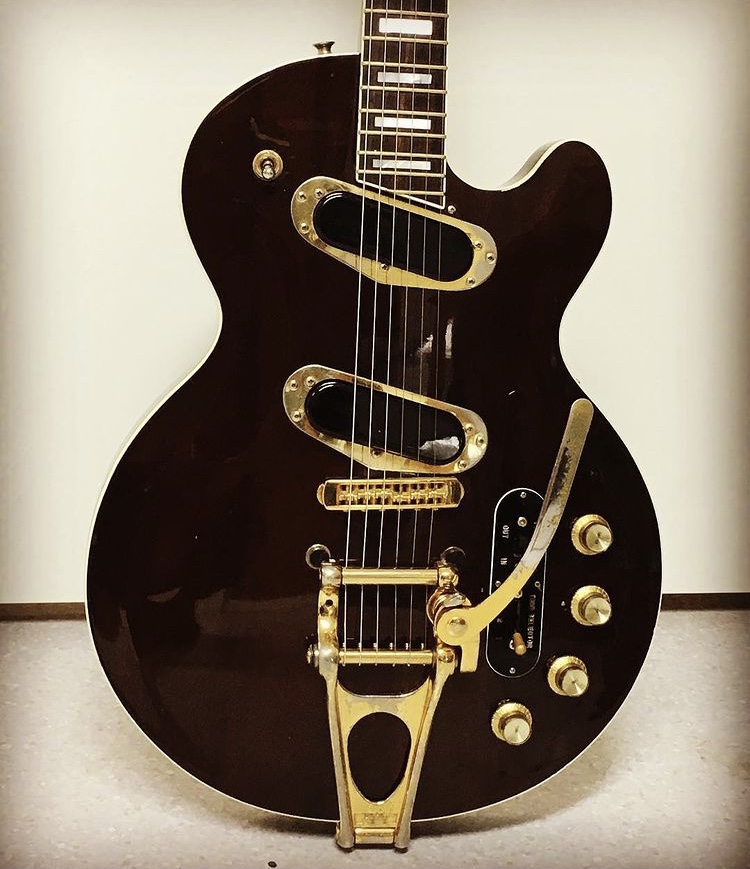
It came with a Bigsby. Looks and plays better without.
MIJ “330”

MIJ «330» (2019)
330 is a 335 without the centre block, originally with one and later two P90s, otherwise the same pickup and control layout, and a trapeze tailpiece. Japanese copies have bolt-on necks, and the ones I know of also have humbuckers.
Seventies Japanese guitar manufacturing is a science in itself. In short, several factories produced models for different distributors, putting on the appropriate logo like Ibanez or CSL or many others. Or not. This is one of a couple of non-logo models I have, and in my opinion that doesn’t lower its desirability or playability. As said before, Ibanez is not a factory, and the capable workers at Fuji-Gen or Matsumoku did indeed produce quality instruments regardless of who placed the order.
This nameless dark cherry model is one of two «330s» I’ve got, the other is a red CSL. There is a lightness in the 330 body that seems to resonate in the sound. Lightness not as in less serious, it is more a feeling of floating on a cloud of sound. Pardon my poetry.







Ibanez 2375/Cimar 1940

Ibanez 2375 «Sunburst Strat» pre-1975 (2020)
Classic strat layout with three-way switch.

Cimar 1940 “Sunburst Strat” 1975 or ’76 (2021)
Same basics as above, but with maple fretboard.
Who wouldn’t want a sunburst Strat? And who wouldn’t want yet another Ibanez from the seventies? Let’s combine.
The 70s Japanese copies never cease to amaze me. Even though I miss the two and four, the sounds are uncannily Strat-like. Feels solid and stays in tune. Vib arm missing, but there are replacements to be found. Back in the days I had this misconception of thinking this was a «solo guitar» and the Tele was a «rhythm guitar». A nice guy in the guitar shop corrected me, and I actually felt enlightened and not intimidated. Thanks again for taking a teenager seriously; I have bought a lot of guitars because of the way guitar shops made me feel worthy.



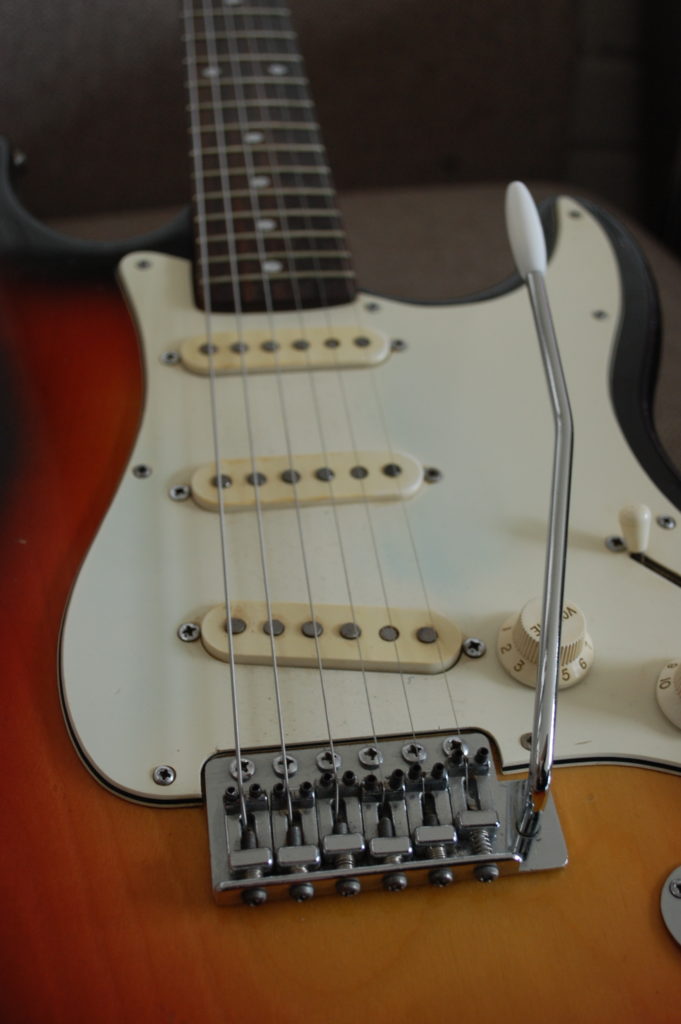

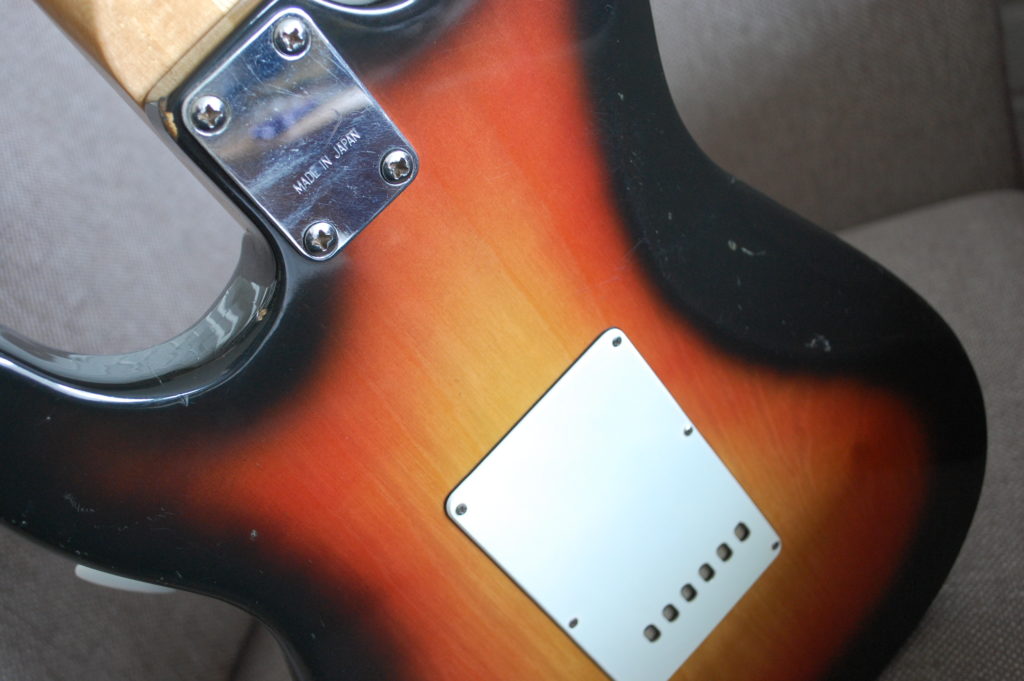

Later the Cimar turned up on eBay, and I could not resist at £180. First one I’ve played with the bridge cover still in place.





Ibanez 2380

Ibanez 2380 «Recording» 1975 (2020)
K752075
There is no way I could have passed on this one. By way of Australia, the joy of reading «You have successfully bought this item» was brought to a halt as the Covid-19 put planes on the ground and got postal services to park their vans. No transporting anything to Norway. Or, as the Norwegian postal service claimed, no receiving anything from Australia. The postal services never agreed on anything. The seller and I agreed on waiting some time for better days, but I ultimately decided to use a slightly more expensive carrier to get it home.
Worth it, and then some. The seller had cleaned and polished, and put on new strings to my specs, and had the knowledge not to slacken the strings for shipping as some amateurs do. Played beautifully at first plug-in. Sounds matching the original, and the fact that the Decade switch was reduced to a Triade on the copy caused a smile and not a frown.



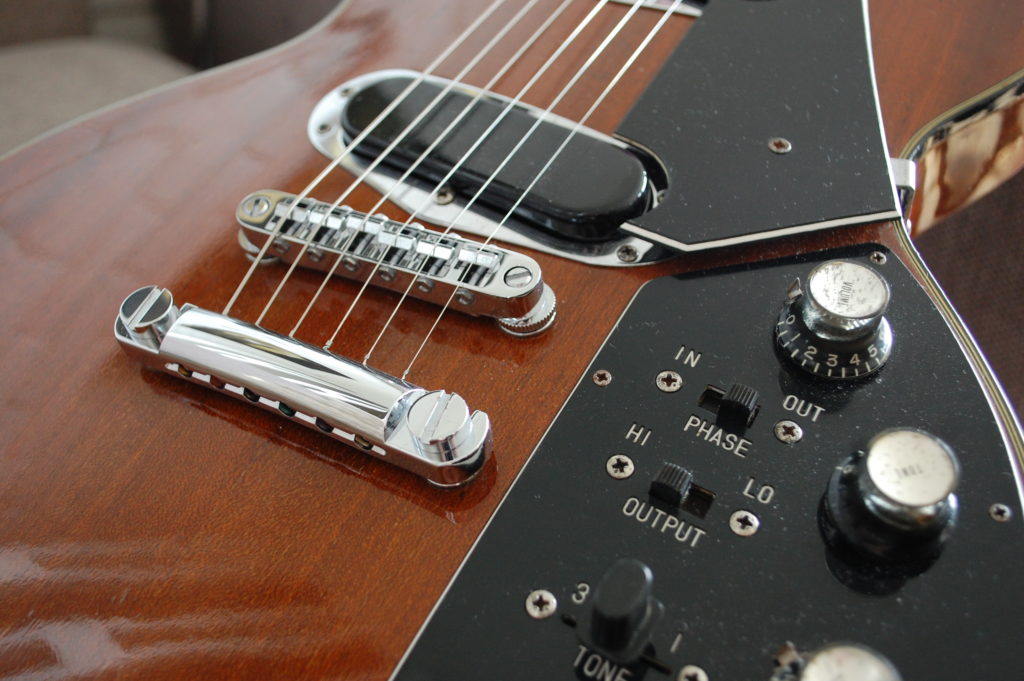




MIJ “Junior”
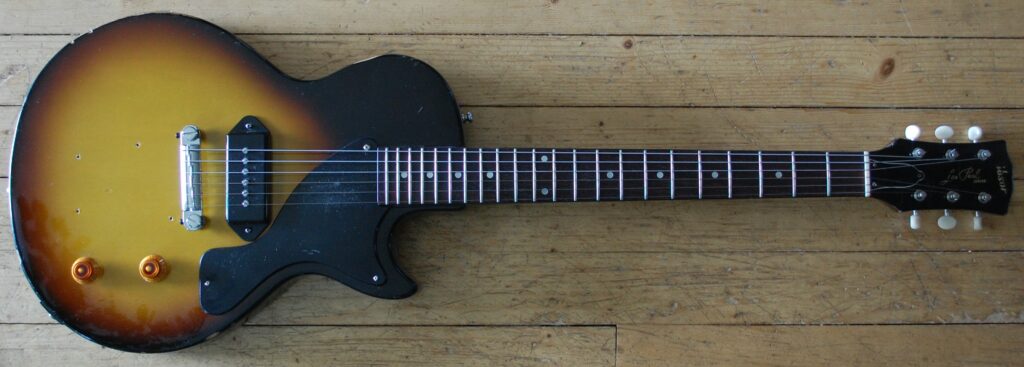
MIJ «Junior»
Set and very solid neck, one P90, one volume one tone. Presented as a possible Antoria on eBay, with obviously fake Gibson decals. Bigsby mounted.
My experience vith Juniors is documented on the proper page. This is the guitar that justified selling two originals, and could easily be in my top five to be saved in an earthquake. Actually, given the right amp it could probably counteract the earthquake and save the world. Have I seen too many films? I think not. This is the one that exceeded the expectations and broke the scale. Of course I removed the Bigsby and put on an intonated wraparound bridge to get it closer to the sunburst Gibson heard on the LP Tales From Topographic Oceans and (in my case) seen with three different Yes lineups, all featuring Steve Howe, of course.
And it exploded. I have several good guitars, and a few excellent ones, but this left my jaw hanging from the first stroke of the pick. The dynamics, the response, the gnarl and bite, without the shrillness and the limitations you would fear to meet in a one pickup guitar. Thank you, Rob.

One of the first trial runs. The Bigsby had to go.




CSL “330”

CSL «330» 70s (2021)
Thinline hollowbody with classic G electronics. Super 70 pickups, original witch hat knobs, replacement Schaller tuners.
CSL guitars were produced in the Fuji-Gen/Matsumoto factory for British importer Charles Summerfield Limited.
Here’s another that nearly got away. The seller had not opened for international shipment, which meant I wasn’t able to bid. He was prepared to ship, I made an offer (thought to be ample) by message, but somehow the communication failed and suddenly it was sold at £100 below what I was prepared to pay. Oh well.
Some days later he messaged me, saying the sale had gone awry; was I still interested?
Of course. We settled on a price, added enough to ensure safe freight, and made a deal. Due to seller’s work schedule I had to spend some extra days waiting, but then it arrived on my doorstep. As agreed he refunded £50 as the shipping cost was lower than first expected.
I gave it the usual shining up and string change, plus turned the neck pickup as it was obviously put in the wrong way round, sprayed the selector switch, and found the action was still a little high. The bridge was at its lowest, so here was the opportunity to step up my setup skills. I removed the neck and put in a small shim in addition to the one already in place. A part of a London HRC membership card worked perfectly. Neck back on, tighten strings, play. And play. There is a soft warmth in this, inviting me to sketch out some moods in the twilight between jazz and blues. Thank you, Boss looper. And thank you, Andy, for sending me that message.



A bit of TLC needed on dry fretboard. Wear is no real problem.



Ibanez 2392

Ibanez 2392 1973 (2022)
Catalogue says: Length 40″, width 17 1/2 x 12 1/2, Pick-Up: Hi-Power, Fingerboard: Rosewood, Position: Pearloid, Finish: Rosewood Top
This seems to be all original. Classic LP layout, pancake body (six layers!), rosewood top with matching headstock, custom headstock inlay and fret markers.
Too beautiful to pass on. The eBay listing said 1975, but it doesn’t appear in catalogues after ’73, so we’ll settle on that. It looked perfect on opening the case, but the action was way too high. After successfully shimming the neck on the “330” I had no fear of doing it again, so now a piece of HRC membership card rests firmly in the neck pocket. Now we’re playing!
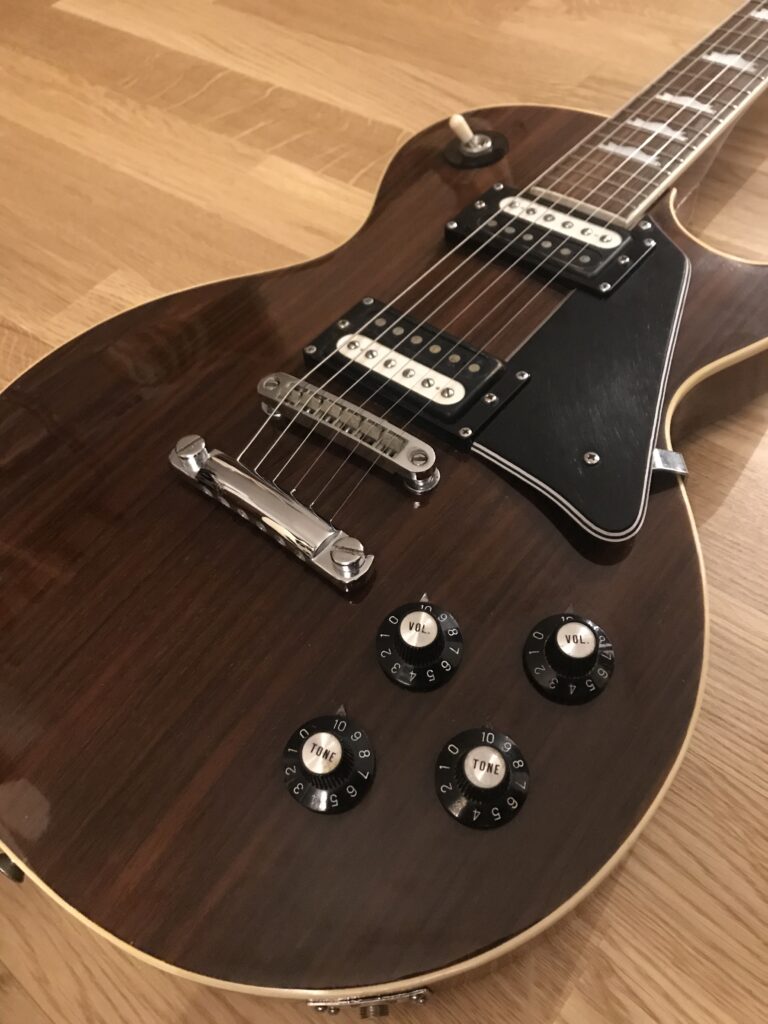






Ibanez 2351DX

Ibanez 2351DX 1975 (2022)
Goldtop Deluxe model featuring mini humbuckers alongside the standard LP layout.
Brings to mind the first Gibson I ever played, an early seventies Goldtop Deluxe owned by Odd Arne Jacobsen who taught me not only the basics, but also a lot of subtle pieces of knowledge I could unwrap long after I had moved and had to proceed by myself. A proper 70s Gibson Goldtop is out of my league financially, so I’ll happily settle for this, and even bear with the headstock having the “post-lawsuit” shape with the dome on top.
I’ve played these two (2392 and 2351DX) to try to figure the differences. The neck pickups are quite similar, but the mini humbucker in the Goldtop has a different bite and feeds the overdrives in a very satisfying way. So, jazz for the rosewood one, and rock for the golden guy. Or the other way around, to ruffle some purists’ feathers.
For both, great feel, great sounds, and pure pleasure to plug and play.
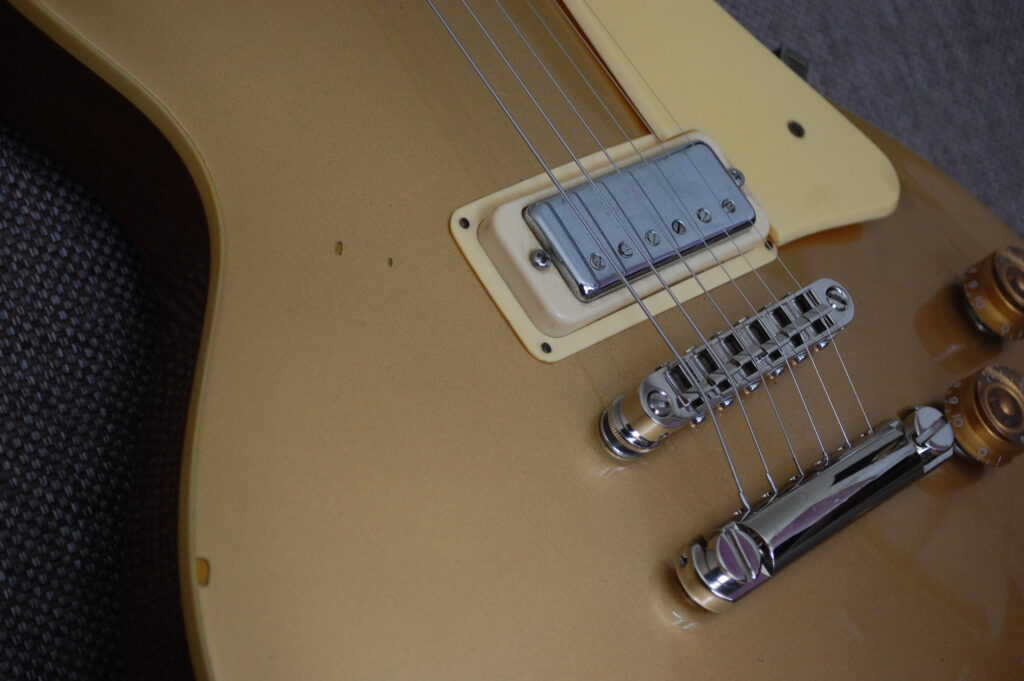
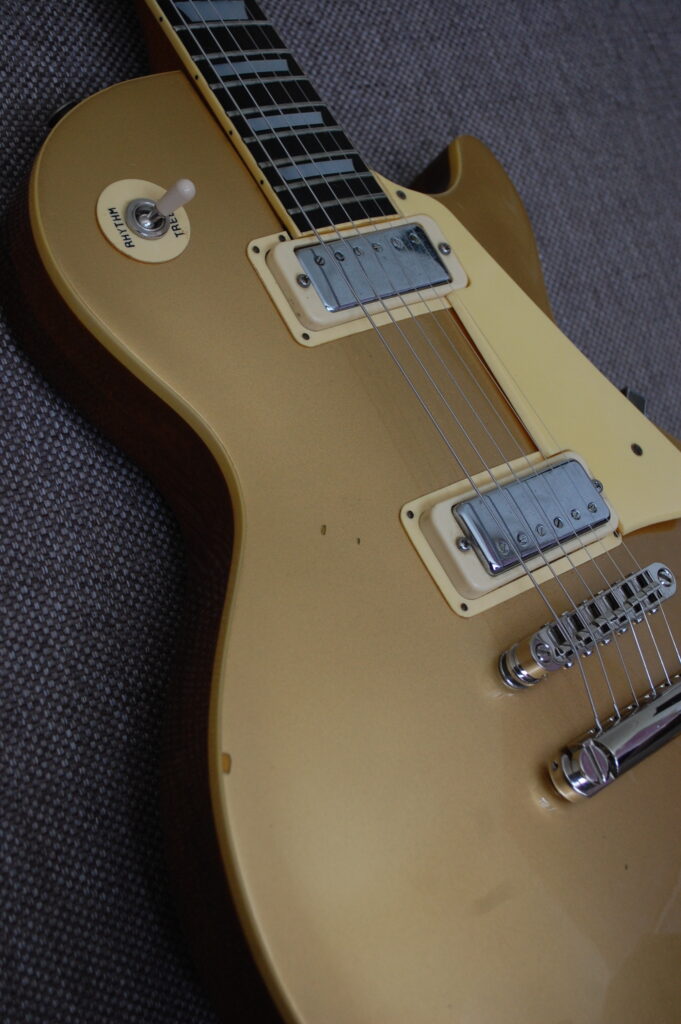


Ibanez 2337DX

Ibanez 2337DX 1976 (2003)
Seriously modified from wraparound bridge with P90s, to Wilkinson bridge and stoptail with mini humbuckers, and back to P90s. Set neck and classic G control layout.


Greco “345”

Greco SA-710 (?) WR 1978 (2024)
Classic two-humbucker Gibson layout, with Varitone as featured on Gibson’s 345 and 355 models. Greco’s homage is very close to the original, but this isn’t stereo. The Varitone is more like a volume switch, works best on five or six. Extremely smooth player! My other two ES-alikes have both bolt on necks, this is glued in. Made by the Fuji-Gen Gakki.





Master and apprentice: The original ES-345 by Gibson, and Greco’s take on the dark cherry version.
Greco SG

Greco SS-600 (2025)
Just like the original with small pickguard, and the standard control layout and set neck.
I enjoyed the Greco 345 so much, I wanted to check out the SG as well. Replacing the Gibson SG Special (looking better with the small guard, covered ‘buckers and trapeze markers) to be a better match with the 70s SG just acquired.
Playing great, and the feeling that everything happens further to the left than usual is to be overcome. Actually, the neck extends further from the body than on the original. I can adapt.








Pnotos show the join at the 21st as opposed to the 19th, and the notable difference in pickup spacing.
The Quiz
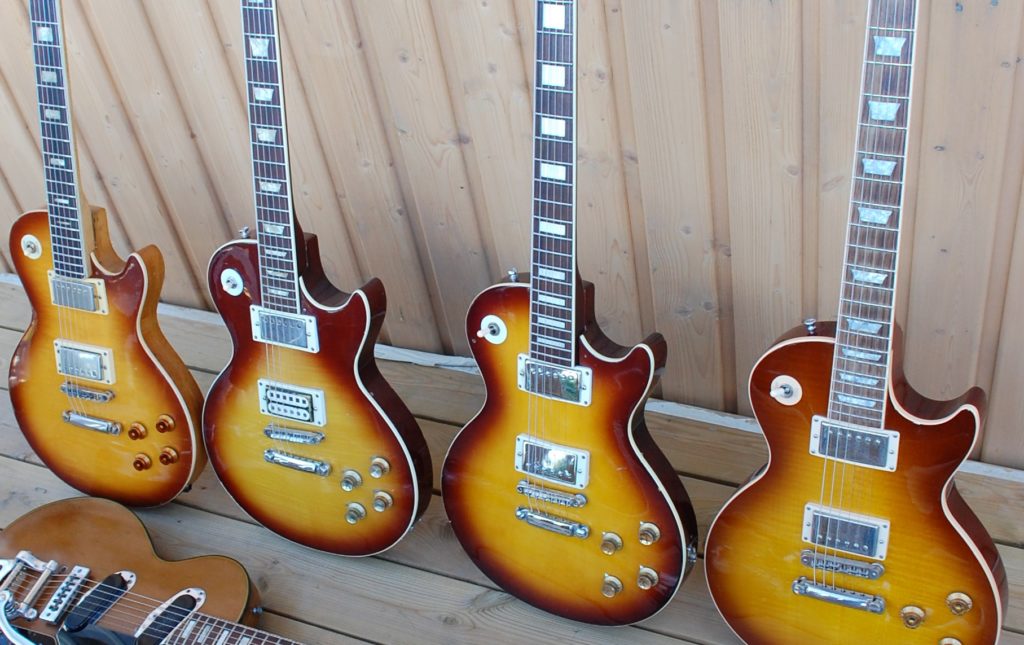
Galleries of masters and apprentices
Always one to be open and including, here I’m presenting a mixed gathering of name instruments along with – well, I keep calling them apprentices, as «copy» implies something second-rate. A copy would have the master’s name on the headstock, pretending to be something it isn’t, but these Ibanezes and Cimars and CSL’s proudly present their makers while proving that heritage is more than blood line.
Both Fender and Gibson have kept producing quality although there have been serious downs through the years. They are not infallible, and have done well to observe the rise in quality presented by other makers, so in these photos I pay tribute to the original designers as well as the workers who may be named John, Juan or Wuhan, who meticulously cut wood or polish frets, who may or may not be players in their spare time, who hopefully take pride in putting together these tools or works of art, depending on point of view.
There are no Messrs. Fender or Gibson in either company these days, so let’s recognise the numerous people who carry their legacy, wherever the factory may be situated. It’s the music that matters in the end. Or, at least that’s what we say, while we ponder on whether we may need another guitar that looks eerily like one already secured in our collection.
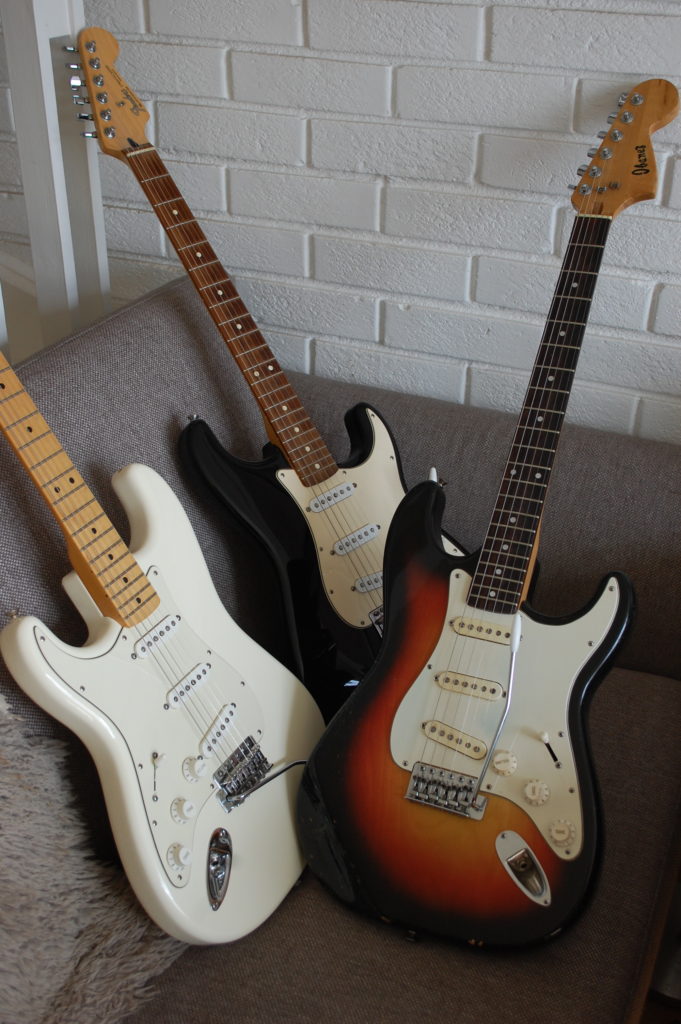


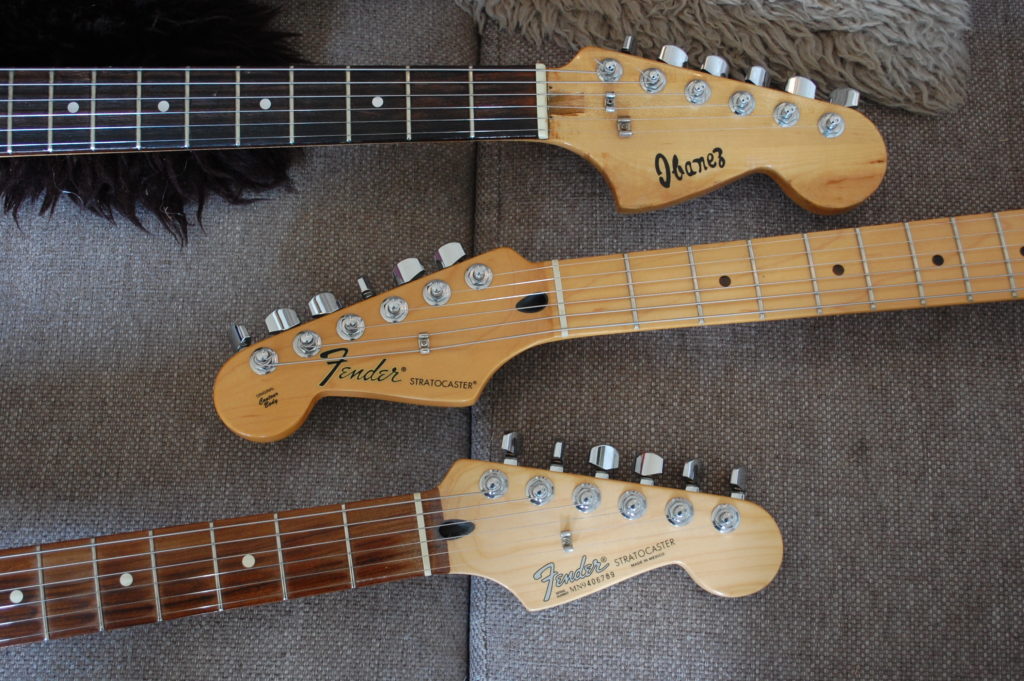
A trio of Strats: Two Fenders and an Ibanez.

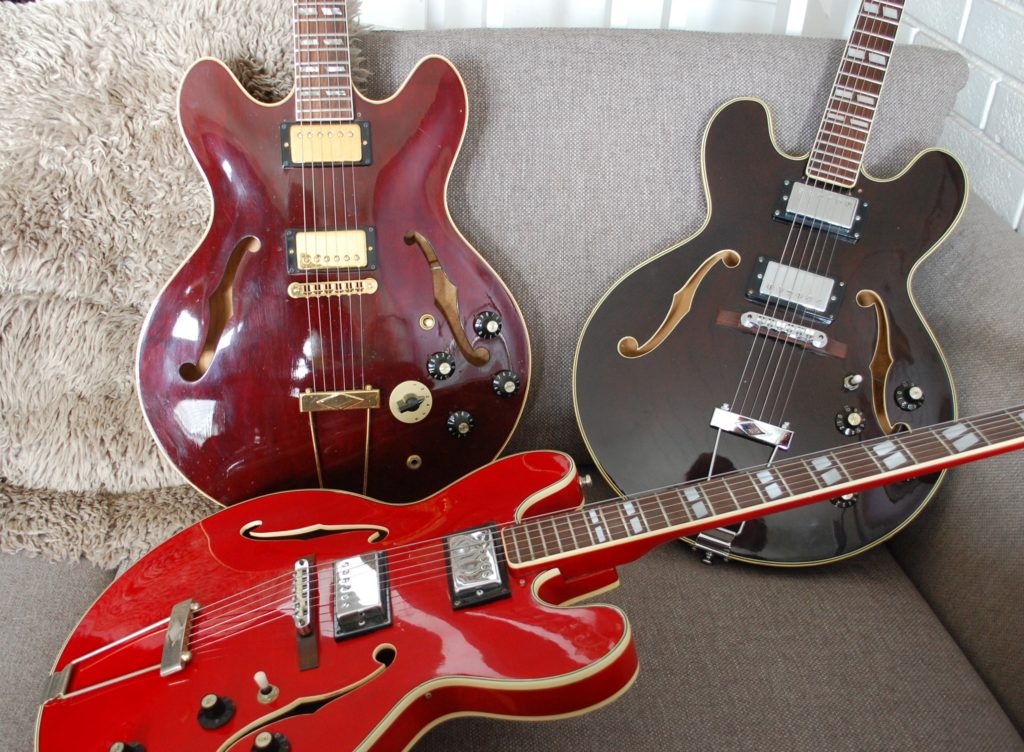

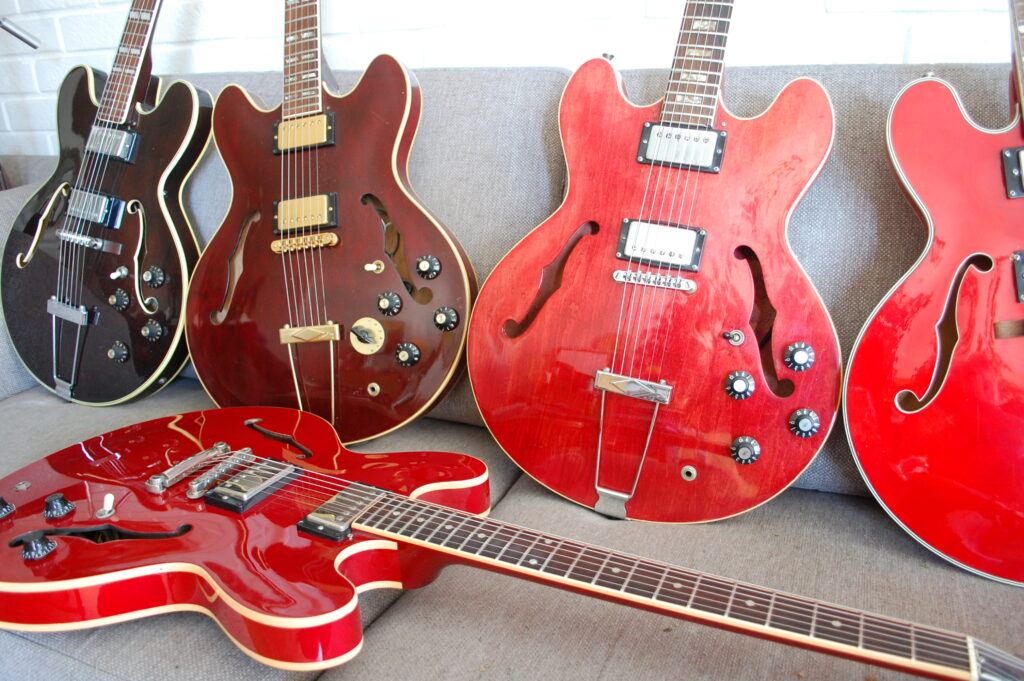


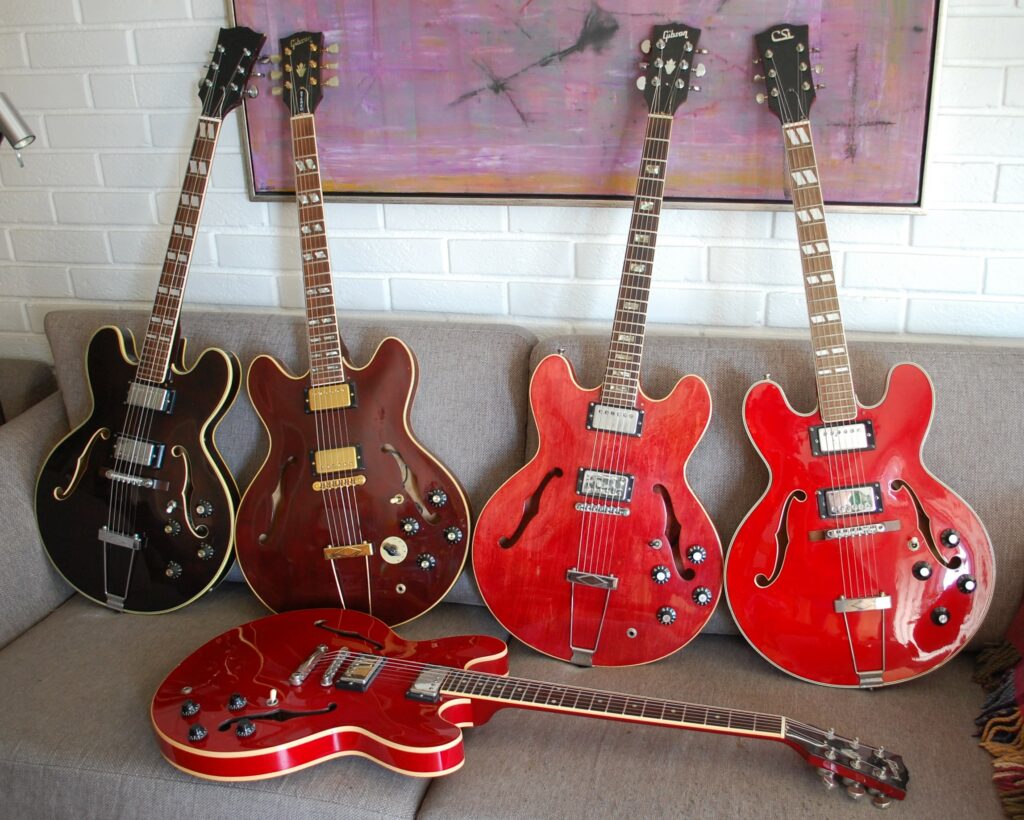
A quartet of 335-ish trapeze artists with stoptail colleague. Left to right on bottom photo: MIJ hollowbody, Gibson 345, Gibson 335 Block, CSL hollowbody. Front: Gibson 335 Dot.
Note that the Gibsons, with centre block, have screwed down bridges, while the hollowbodied apprentices have floating bridges.





A trio of low-impedance Les Paul-favourites: Ibanez Professional, Ibanez Recording, and the master himself: 1972 Gibson Les Paul Recording


Two red ones: Gibson ES-335 (left) and CSL “330”. The 330 is all hollow, so the trapeze tailpiece is required. The 335 series comes with various tails – trapeze, stoptail or Bigsby.





Master and apprentice; the one and only American Rickenbacker 4001 – and an Ibanez copy that comes eerily close in looks. Build quality is something else – the 2388 required some serious fixing.


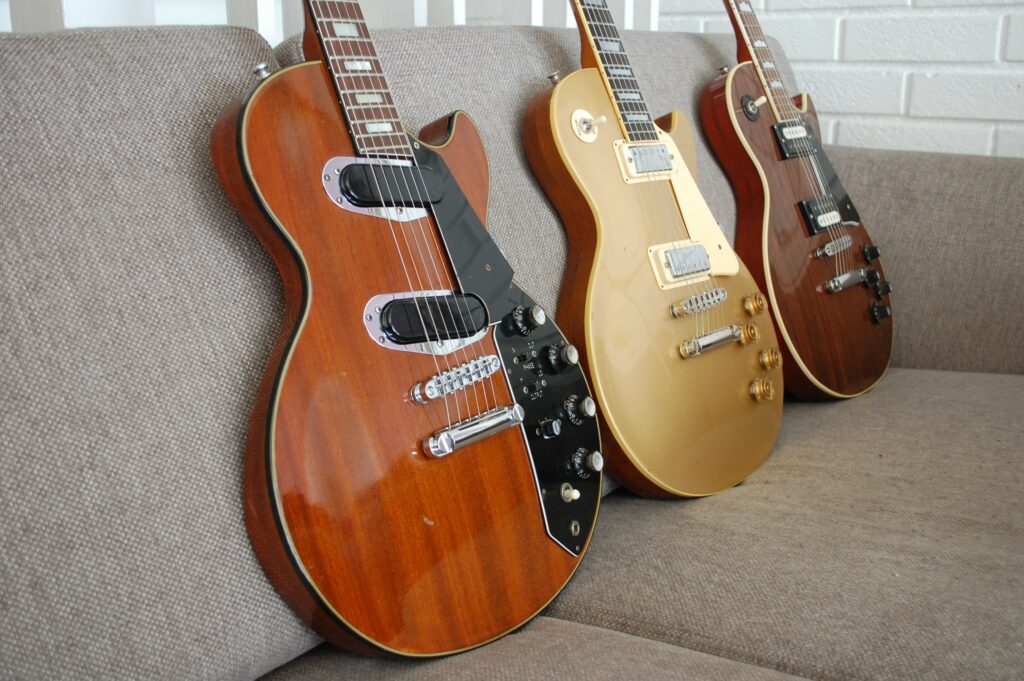


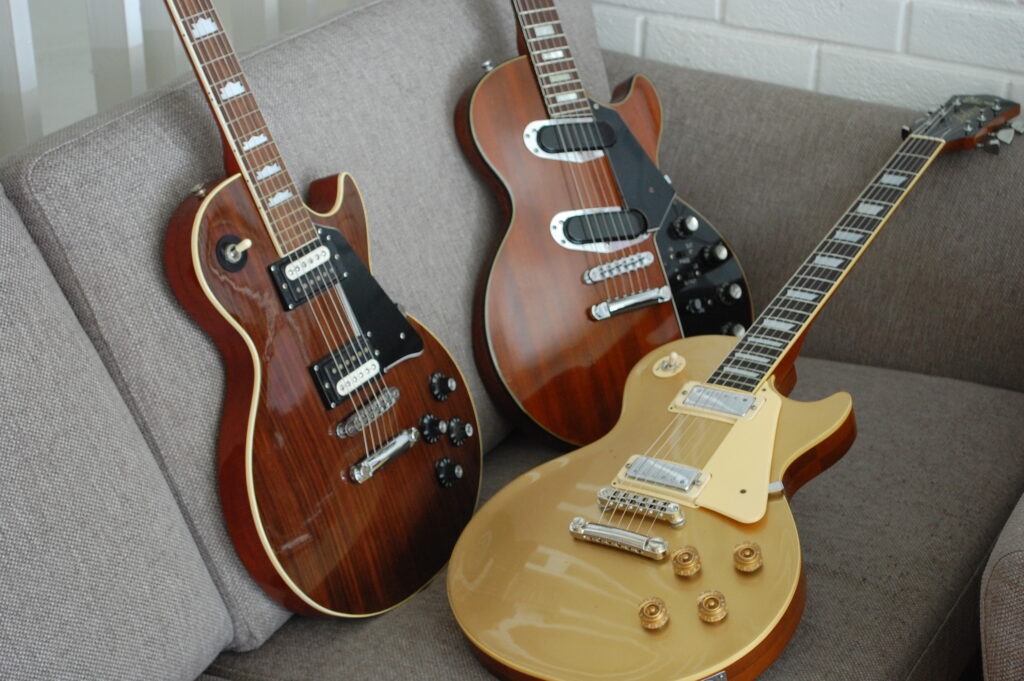
A trio of Ibanez “LP’s” differing from the usual Sunburst versions: One Goldtop, one Recording, and the third is a Custom of which I am not sure what Gibson model it is based on.


Two Goldtops, Ibanez Deluxe and Gibson Standard. Thickness and weight are notably different.
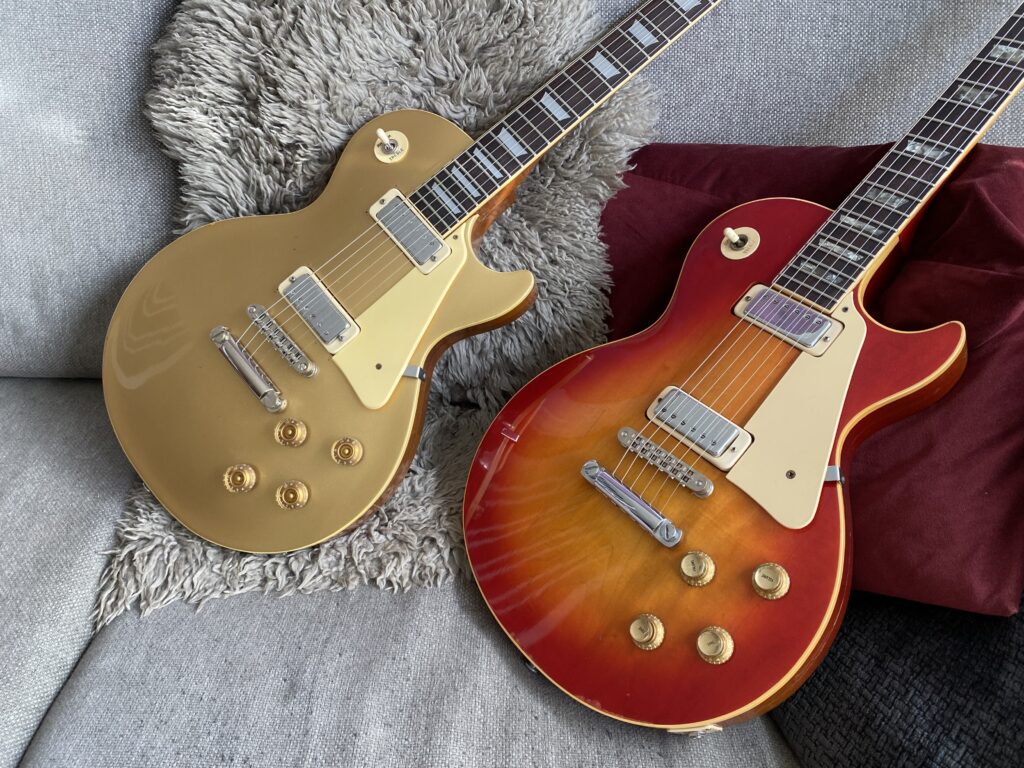
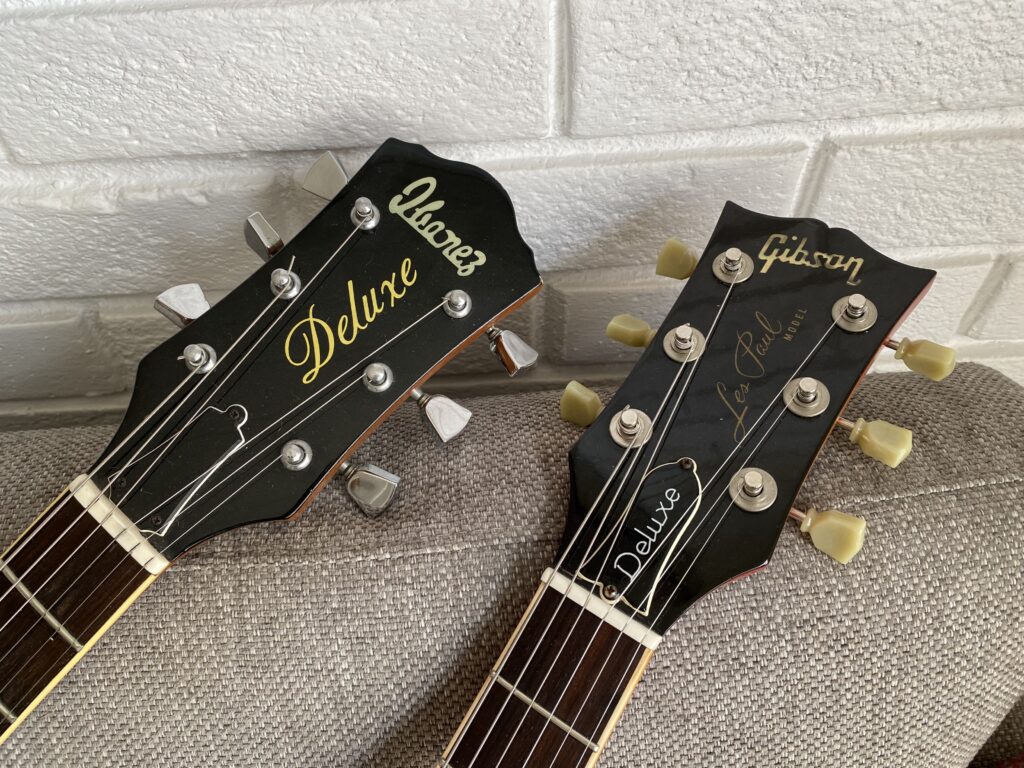

Deluxe versions from Ibanez (gold) and Gibson (sunburst).




Gibson Les Paul Junior, and copy with scratchable “Gibson” decal. Actually, the copy has the yellow knobs featured on the first production models. Note also pickup placement, closer to the bridge on the legitimate model according to pre-1956 specs.




The Junior/Special corner. Two Gibsons flanking a nameless (or fake logo) Junior and an Ibanez Special.
Tour
Too loud? The seventh stop on the tour presents some acoustics.